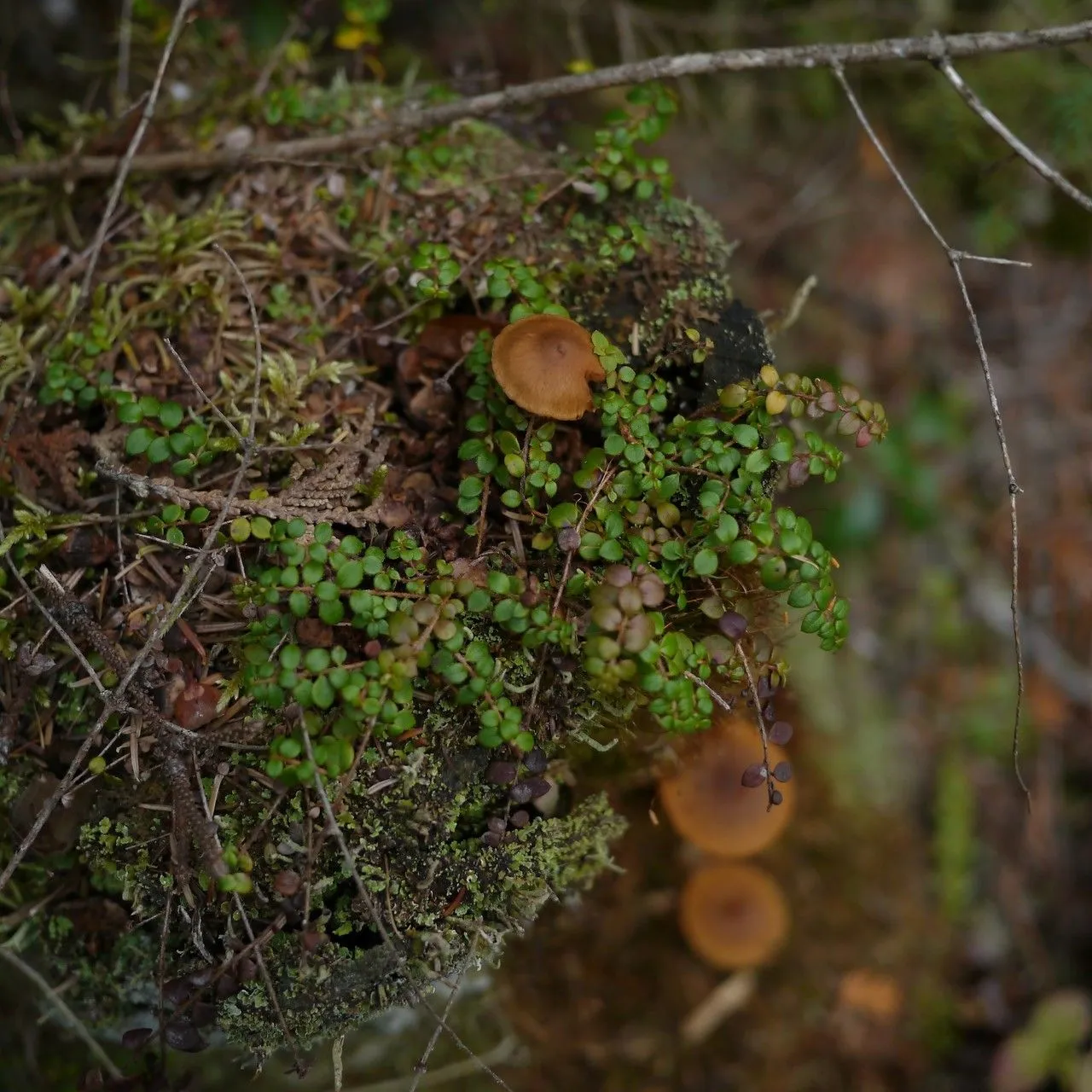
Author: (L.) Muhl. ex Bigelow
Bibliography: Fl. Boston., ed. 2: 165 (1824)
Year: 1824
Status: accepted
Rank: species
Genus: Gaultheria
Vegetable: False
Observations: Subarctic America to Canada, N. U.S.A. to Maryland
Creeping Snowberry, scientifically known as Gaultheria hispidula, is a perennial plant prized for its distinctive ground-covering abilities and cold-climate hardiness. Belonging to the Ericaceae family, this low-growing evergreen forms a dense mat of delicate, trailing stems, capable of spreading efficiently across the forest floor. It has minute, rounded leaves that are often tinged with a gentle luster, enhancing its charming appearance.
This plant flourishes in the subarctic regions of America, extending its reach through Canada and the northern United States down to Maryland. It thrives in shady, moist forest environments where the soil is rich in organic matter, reflecting its natural woodland habitat. Creeping Snowberry stands out not only for its resilience in cold climates but also for its tiny, bell-shaped flowers that bloom in late spring to early summer. These white flowers, though small, add a touch of elegance to the plant’s greenery.
Following the flowering period, Creeping Snowberry produces its namesake berries. These berries are small and white with a mild, wintergreen flavor, providing a subtle but delightful taste experience. The berries are edible and attract a variety of wildlife, ranging from birds to small mammals, which find nourishment in these fruits.
The thick carpet of Creeping Snowberry also serves ecological purposes. It helps prevent soil erosion by holding the soil intact with its roots, and it offers habitat for numerous critters. In addition to its environmental benefits, this ground-covering species is admired for its ornamental value, providing a lush, verdant ground cover that can add a natural, aesthetically pleasing touch to gardens and landscape designs.
An enduring symbol of the adaptability and beauty of the flora in cooler climates, Gaultheria hispidula remains an integral part of the biodiversity in the regions it inhabits. First described in the early 19th century, it continues to fascinate botanists and plant enthusiasts alike, maintaining an essential role in both natural ecosystems and human cultivation efforts.
Eng: cancer wintergreen, creeping snowberry, maidenhair berry, moxieplum, snowberry
Fra: petit thé, chiogène hispide, gaulthérie hispide, oeufs de perdrix
En: Creeping snowberry, Cancer wintergreen, Maidenhair berry, Moxieplum, Snowberry
Fr: Petit thé, Chiogène hispide, Gaulthérie hispide, Oeufs de perdrix
Taken Apr 17, 2021 by Frederic Michaud (cc-by-sa)
Taken May 29, 2019 by Daniel Ross (cc-by-sa)
Taken Oct 18, 2020 by Jacynthe Barrette (cc-by-sa)
Taken Apr 5, 2021 by Philippe St-Pierre (cc-by-sa)
Taken Aug 12, 2020 by Judith Ouellet (cc-by-sa)
Taken Jul 26, 2017 by Tara Conler (cc-by-sa)
Taken Sep 1, 2019 by Neo Winter (cc-by-sa)
Taken Aug 11, 2021 by David Tremblay (cc-by-sa)
Taken Sep 1, 2019 by Neo Winter (cc-by-sa)
Taken Aug 14, 2015 by EOL − Charlie Hohn (cc-by-nc)
Taken Jun 8, 2014 by EOL − Charlie Hohn (cc-by-nc)
Taken Oct 27, 2015 by EOL − bendingtree (cc-by-nc)
Taken Aug 31, 2014 by EOL − Charlie Hohn (cc-by-nc)
Taken Oct 27, 2015 by EOL − bendingtree (cc-by-nc)
Taken Jan 27, 2013 by EOL − sallen (cc-by-nc)
Growth form>: Stoloniferous
Growth habit>: Subshrub, Shrub
Growth rate>: Slow
Ph maximum: 6.5
Ph minimum: 4.0
Family: Myrtaceae Author: (F.Muell.) K.D.Hill & L.A.S.Johnson Bibliography: Telopea 6: 402 (1995) Year: 1995 Status:…
Family: Rubiaceae Author: Pierre ex A.Froehner Bibliography: Notizbl. Bot. Gart. Berlin-Dahlem 1: 237 (1897) Year:…
Family: Sapindaceae Author: Koidz. Bibliography: J. Coll. Sci. Imp. Univ. Tokyo 32(1): 38 (1911) Year:…
Family: Asteraceae Author: A.Gray Bibliography: Pacif. Railr. Rep.: 107 (1857) Year: 1857 Status: accepted Rank:…
Family: Fabaceae Author: Medik. Bibliography: Vorles. Churpfälz. Phys.-Ökon. Ges. 2: 398 (1787) Year: 1787 Status:…
Family: Aspleniaceae Author: (Cav.) Alston Bibliography: Bull. Misc. Inform. Kew 1932: 309 (1932) Year: 1932…